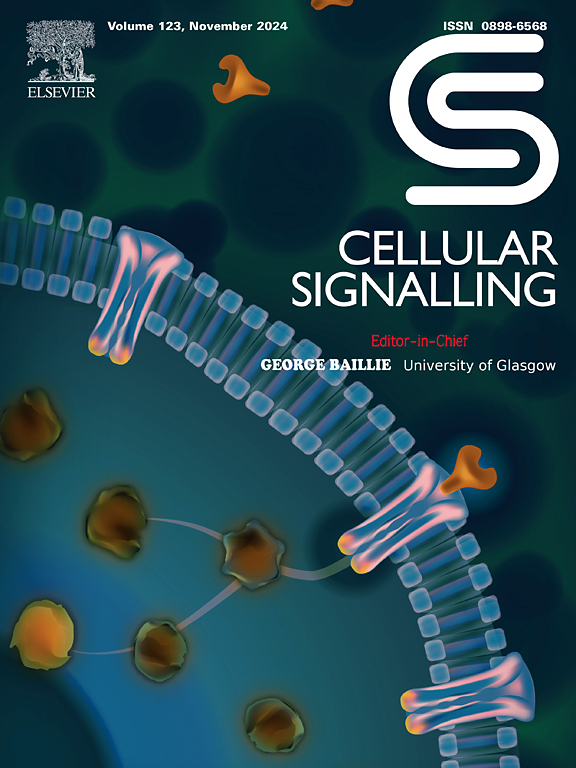PRAP1通过Nrf2信号通路调控结直肠癌细胞增殖和铁下垂。
IF 4.4
2区 生物学
Q2 CELL BIOLOGY
引用次数: 0
摘要
背景:结直肠癌(CRC)是一种常见的影响消化道的癌症,目前的治疗方案有局限性。研究证实,铁下垂在结直肠癌的进展中起关键作用。本研究旨在阐明富含脯氨酸的酸性蛋白1 (PRAP1)如何影响结直肠癌的进展和铁凋亡,并揭示其中的潜在机制。方法:采用实时荧光定量PCR (RT-qPCR)和western blot检测CRC细胞(SW480、SW620和LOVO)及组织中PRAP1的表达水平。免疫荧光法定位PRAP1。采用CCK-8法、EdU染色法、Transwell染色法、TUNEL染色法和Scratch-wound法测定结直肠癌细胞的生物学特性。采用普鲁士蓝染色和铁含量测定试剂盒测定铁和Fe2+含量。建立裸鼠移植瘤模型,病理染色观察PRAP1对肿瘤生长的影响。Western blot检测凋亡相关蛋白及Nrf2途径蛋白的表达。结果:CRC中PRAP1水平升高。PRAP1过表达促进细胞增殖,抑制细胞凋亡和铁下垂。此外,PRAP1过表达可以激活Nrf2通路。然而,沉默PRAP1具有相反的效果。体内肿瘤异种移植实验表明,沉默PRAP1可使肿瘤组织中Ki67阳性降低,TUNEL阳性升高,阻断Nrf2通路,从而抑制肿瘤生长。结论:PRAP1通过Nrf2途径促进结直肠癌细胞增殖,抑制铁下垂。该研究为新型靶向药物的开发提供了一个概念框架。本文章由计算机程序翻译,如有差异,请以英文原文为准。

PRAP1 regulates colorectal cancer cell proliferation and ferroptosis through the Nrf2 signaling pathway
Background
Colorectal cancer (CRC) is a common type of cancer that impacts the digestive tract, and current treatment options have limitations. Studies have confirmed that ferroptosis plays a key role in CRC progression. This research sought to clarify how Proline-rich acidic protein 1 (PRAP1) influences CRC advancement and ferroptosis, and to uncover the underlying mechanisms involved.
Methods
Real-time quantitative PCR (RT-qPCR) and western blot were employed to ascertain the levels of PRAP1 in CRC cells (SW480, SW620, and LOVO) and tissues. Immunofluorescence was utilized to locate PRAP1. Biological characterization of CRC cells was determined through CCK-8 assay, EdU staining, Transwell assay, TUNEL staining and Scratch-wound assay. Iron and Fe2+ content was measured using prussian blue staining and iron assay kit. A nude mouse model of xenograft was established, and the impact of PRAP1 on tumor growth was investigated by pathological staining. Expression of ferroptosis-related proteins as well as nuclear factor-erythroid factor 2-related factor 2 (Nrf2) pathway proteins was detected by Western blot.
Results
PRAP1 levels were elevated in CRC. Overexpression PRAP1 promoted cell proliferation, inhibited apoptosis and ferroptosis. Additionally, overexpression PRAP1 can activate the Nrf2 pathway. However, silencing PRAP1 had the opposite effect. In vivo tumor xenograft experiments showed that silencing PRAP1 resulted in decreased Ki67 positivity and increased TUNEL positivity in tumor tissues, and blocked Nrf2 pathway, thereby inhibited tumor growth.
Conclusion
PRAP1 promotes CRC cell proliferation and inhibits ferroptosis by Nrf2 pathway. This study provides a conceptual framework for the development of novel targeted drugs.
求助全文
通过发布文献求助,成功后即可免费获取论文全文。
去求助
来源期刊

Cellular signalling
生物-细胞生物学
CiteScore
8.40
自引率
0.00%
发文量
250
审稿时长
27 days
期刊介绍:
Cellular Signalling publishes original research describing fundamental and clinical findings on the mechanisms, actions and structural components of cellular signalling systems in vitro and in vivo.
Cellular Signalling aims at full length research papers defining signalling systems ranging from microorganisms to cells, tissues and higher organisms.
 求助内容:
求助内容: 应助结果提醒方式:
应助结果提醒方式:


